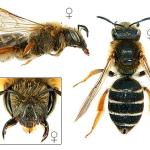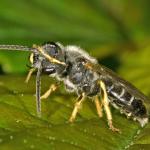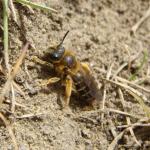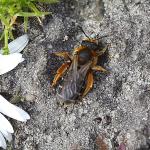Halictus nidulans WALCKENAER 1817; Halictus lerouxii LEPELETIER 1841; Halictus quadrifasciatus SMITH 1870; Halictus lerouxii var ruborum COCKERELL 1898; Halictus lupinelli COCKERELL 1939; Halictus frater PESENKO 1984
One of the largest British halictine bees with a body length often over 10 mm. It is a distinctive bee with strong white pubescent bands on the apices of the abdominal segments and yellow-orange legs in both sexes.
Widely distributed throughout Britain and known from Ireland (Antrim). It is rarely abundant at any one locality in the south, but is frequently encountered in dense nesting aggregations in northern Britain. The species occurs in both the Palaearctic and the Nearctic regions, where it is largely confined to temperate habitats.
This bee is not regarded as being scarce or threatened.
Often present in a wide variety of habitats. Nests are usually made in areas of vertical or sloping bare ground with a southern aspect (Potts & Wilmer 1998). No other habitat limitations known.
The species is eusocial, with queens emerging from hibernation in April, workers present from May onwards and males and new females from July to early October. There have been suggestions that two generations of sexuals are produced in some years (G M Spooner, pers. comm.).
Nests are made in the ground and may be single or in aggregations. Individual nests support a small eusocial population, founded by a mated queen in the spring. This queen rears a small number of workers and then the colony produces new males and females at the end of the summer.
The bee may be found visiting a wide range of flower species, but is probably most often found at those of the Asteraceae.
Two cleptoparasitic bees attack this species: Sphecodes gibbus and S. monilicornis. It is also recorded as being attacked by the conopid fly Zodion cinereum (K G V Smith 1969).
Proofed: January 2012





